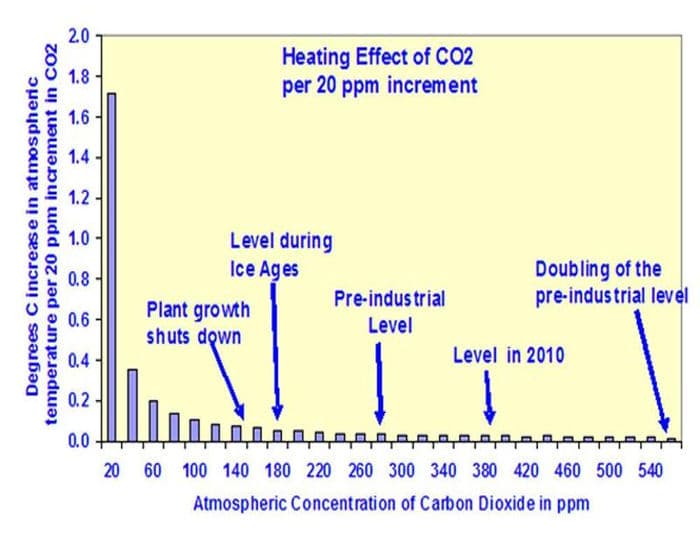The effect of CO2 in the globe’s atmosphere on global temperature is the result of the absorption of infrared radiation emitted from the surface of the globe toward space. The quantity of radiation emitted by the surface of the globe is finite. CO2 absorbs infrared radiation only in limited portions of the radiation spectrum. As the concentration of CO2 in the atmosphere increases, the fraction of the radiation in those portions of the spectrum absorbed by CO2 increases, within the limits of the total radiation emitted in those portions of the spectrum. Therefore, as the CO2 concentration increases, the quantity of radiation available to be absorbed by the next increment of CO2 decreases logarithmically, as shown in the graph below.

AMO physicists William van Wijngaarden and William Happer have recently completed an extremely detailed study of radiation absorption by the principal “greenhouse” gases including water vapor (H2O), carbon dioxide (CO2), ozone (O3), nitrous oxide (N2O) and methane (CH4). Their paper has been released as a preprint entitled “Dependence of Earth’s Thermal Radiation on Five Most Abundant Greenhouse Gases”. Their research regarding CO2 determined that the wavelengths at which CO2 absorbs radiation from the surface of the globe are essentially “saturated”, meaning that the current concentration of CO2 in the atmosphere is sufficient to absorb virtually all the radiation emitted at the wavelengths in which CO2 absorbs.
This is an extremely important conclusion, since it indicates that emission of additional CO2 into the atmosphere will have little or no effect on global temperatures, confirming the logarithmic relationship shown in the graph above, but based on far more detailed research. The conclusion confirms that there is no climate “crisis” now and that there would be no climate crisis in the future, regardless of the quantity of additional anthropogenic CO2 emissions.
The conclusions of this study are obviously inconsistent with the consensed climate science community’s narrative and with the political science narrative of the UN and numerous national governments and NGOs. They would be even less consistent with the revised narrative being prepared for the IPCC Sixth Assessment Report and with the projections embodied in the CMIP6 ensemble of climate models.
The authors released the report as a preprint after it was rejected for publication by three peer reviewed journals. These rejections of the work of two renowned scientists recall the efforts of the consensed climate science community to prevent publication of research which does not support the consensus narrative, as revealed in the Climategate emails in 2009 and 2010. It is extremely likely that this research will not be included in the IPCC Sixth Assessment Report for the same reason.
It is long since time for the consensed climate science community to transition from defending the narrative to advancing the science. This cannot occur in an atmosphere in which serious scientific research is ignored or worse buried. The consensed climate science community is aware of the weaknesses of its narrative and the public is becoming increasingly aware as well, due to the history of failed predictions of imminent calamity.

